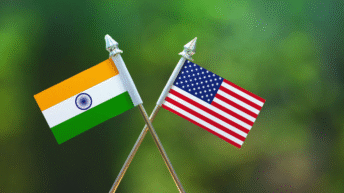
Among the trinity of Hindu Gods, Brahma, Shiva and Vishnu, Shiva is considered to be the destroyer of the worlds, paving the way for its regeneration. The precursors of Shiva are found in the Rigveda and the Atharvaveda where he is identified as Rudra. In the later phases of the Vedic period, Rudra takes on many aspects of other Vedic deities and his stature grows extensively. He shares certain characteristics with Agni and Indra too. He is referred by the following names as listed in the Brahmana texts: Rudra, Sharva, Bhava, Ugra, Ashni, Pashupati, Mahadeva and Ishana. These names continue to be the epithets of Shiva in Puranic times.
Skanda Purana, dated between the 6th and 7th centuries CE, mainly focuses on devotion to Shiva. It promotes Shiva as the supreme, all-pervading entity whose consort is Shakti or Parvati. Other Puranas such as the Vayupurana, Matsyapurana, Kurmapurana, Lingapurana, Shivapurana too have much literature related to Shaiva concepts and stories.
The image of Rudra Shiva as the supreme God has been popular since the late Vedic times. By the Puranic age his sampradaya or cult became common in the Hindu society. In the Puranic age, emerged the iconic form of Rudra Shiva who was until then perceived in the Vedic times only through hymns and words. The most famous and till date worshipped form of him is the Linga; a phallic symbol.
Lakulish, Mahakuta Group of Temples, Karnataka (Source: Corinna Wessels Willliam)
The earliest sampradaya of Shiva was the Pashupat Shaivism. Lakulisha, a prominent Shaivite revivalist, reformist and preceptor of the doctrine of the Pashupatas, considered as an incarnation of Shiva, was worshipped by his followers by crafting idols in and on the temples. Another sect of non-puranic Shaivites was the Kapalikas who traditionally carried a skull-topped trident (Khatvanga) and an empty skull as a begging bowl. Other attributes associated with Kāpālikas were the ashes from the cremation ground with which they smeared their bodies. They revered the fierce Bhairava form of Shiva. In the Deccan region, a similar sect called the Kalamukhas gained prominence. After the decline of Kalamukhas, Vira-Shaivas dominated the Deccan. In the Kashmir region flourished the Trika Shaivism which was also based on Shaiva Siddhanta. In the south, in Tamilnadu especially, the Siddhanti Shaivas dominated.
Gudimallam Linga, Gudimallam, Andhra Pradesh (Source: ASI)
The iconography of Shiva is vast and varied; however, the aniconic phallic form, i.e. Linga has remained constant and preferable throughout the centuries. Shiva emerging from the Phallic symbol at Guddimallalingam (pic above) is an example of the early Shiva idol.
Mukhalinga, Gupta Age, Madhya Pradesh (Source: Metropolitan Museum of Art )
Just like Vaishnavism, Shaivism too believes in Shiva incarnations. Bhairava, Virabhadra, Lakulisha, Sharabha, Harihara, Dakshinamurti are considered to be Shiva incarnates. The Shaiva Puranas have also brought out various other forms of Shiva such as Gajasurasamhara Shiva, Tripurantaka Shiva, Andhakanta Shiva, Ekapada Shiva that were the subject of sculpture art during the development of various Shaiva sects and cults. Apart from these forms, the Linga form of Shiva was also modified, converted into Mukha-linga i.e. Shiva’s face is carved on the linga. Sometimes only Shiva’s face was carved on linga, while sometimes, the composition of main Gods such as Brahma, Vishnu, Surya was also carved along with Shiva on the linga on its four sides.
Shiva and Yaksha, Kushan Age, Mathura (Source: Nasli and Alice Heeramaneck Collection)
In the Kushana period, Shiva had some influence of Yaksh over his iconography where some of the attributes of Shiva were added over the icon of Yaksha. There are many Shiva idols found in the Mathura region from the Kushana period. Besides, the most important factor in Shiva iconography was the horizontal placing of his third eye. In the Gupta age, the position of the third eye becomes vertical from horizontal. Apart from his various forms, the Mukha-linga concept gained immense popularity. In south India, the Nataraja, Dakshinamurti, Ardhanarishvara forms of Shiva became widespread.
Dakshinamurty Shiva, Tamil Nadu (Source: RK Lakshmi)
The Guddimallalingam Shiva is one of the finest early specimens of Shiva iconography. The curled hair on Shiva’s head is especially worthy of note where he is standing on a dwarf and holding a bow, and a short animal in his hands. The 4th to 5th century CE dwarf Shiva found in Maharashtra now exhibited in the National Museum is also a unique representation of the deity. Shiva is depicted as a dwarf with a big belly and short hands and feet. He holds the crescent moon and a skull on his head.
Dwarf Shiva, Vakataka Age, Maharashtra (Source: National Museum, New Delhi)
Trimurti Shiva, Elephanta Caves, Maharashtra (Source: Christian Haugen)
Shiva Vrishabhavana, Chola Period, Tamil Nadu
The famous Shiva Trimurti from Gharapuri is a superb work of art. Here, three various forms of Shiva are carved together to form a three-headed figure. The eight-handed Shiva reclining on the bull from Aihole Durga temple is quite exquisite in form and crafting. During the Chola period in south India, some fine specimens of Shiva bronzes were crafted, the most famous one being the slender figure Shiva reclining on a bull also known as Shiva Vrishbhavana and the dancing form known as Nataraja . The origin of Nataraja takes us to the famous Tandava dance of Lord where is doing the act of destruction. The earliest form of Nataraja is housed in the famous temple of Chidambaram which was also the coronation site of the Chola kings for many years. The formation of matted locks on the head is again one of the greatest works of craftsmanship.
Nataraja, Chola Age, Tamil Nadu (Source: Wikipedia)
The variations in the iconography of Shiva from the Vedic period to the medieval times evince the culmination and assimilation of various cultural and religious thoughts throughout history. The iconographical development of Shiva along with Vishnu’s has been an important element of ancient Indian art which can help us to study the cross-traditional understanding of Hindu deities.






Very nice…i appreciate your work.